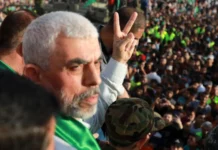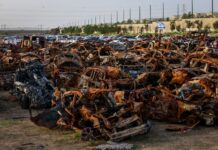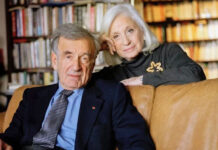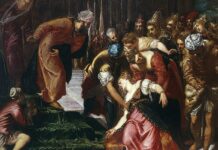The protest outside the church at Birkenau during last month’s commemoration of the 75th anniversary of the liberation of the Auschwitz death camp should not have come as a surprise.
The presence of Christian symbols and places of worship at what is basically the largest Jewish cemetery in the world has been a contentious issue for decades, highlighting the complexities and challenges of how to preserve the extermination site while accurately perpetuating the memory of the an estimated 1.1 million Jews were systematically murdered there.
For Rabbi Avi Weiss, the New York-based activist and president of the Coalition for Jewish Concerns-Amcha, who led the recent demonstration against the Birkenau church, it’s a matter of time.
“Soon, when the survivors and even second generation are gone, all we’ll have are scholarly books and the physical remnants of history—most tellingly, the death camps. Those remnants, from which future visitors will learn about the Holocaust, will stand as the mute monuments of memory,” he told JNS.
The Coalition for Jewish Concerns is asking that the church, which is topped by a large cross, be moved back into the nearby village from the building it occupies, which served as the SS commandant’s headquarters.
The Birkenau church, says Weiss, with its inescapable Christian presence, represents “one of today’s most imminent threats to the integrity of Holocaust memory.”
If it’s allowed to stay, “it might lead future visitors to conclude that the Catholic Church was in the forefront of speaking out in defense of Jews targeted for annihilation when, in fact, it turned its back on Jews desperate for help. While there were righteous gentiles who, at great risk, saved Jewish lives, the Vatican was nowhere to be found,” asserts Weiss.
There’s a precedent for such a move. But the removal of a Carmelite convent from Auschwitz took years and illustrates how many international, national, local, religious and political bodies are involved in the struggle over preservation and memory at the Polish site.
A crucial disagreement over the Birkenau church is whether the SS commandant’s building was within the perimeter of the camp and therefore a violation of international agreements that forbid places of worship within the camp.

Weiss bases his understanding on a 1944 Allied aerial map, saying “the inmates—those destined to be murdered, to be gassed—were kept within the barbed wire.
Just outside was the Nazi commandant’s HQ, which today houses the Birkenau church. Behind the headquarters were SS barracks. Allied aerial photographs clearly indicate that the headquarters, as well as the barracks, were in the Birkenau complex.”
‘The problems of communism’
Father Mateusz Kierczak, communications director of the Bielsko-Zywiec diocese that includes the Auschwitz-Birkenau concentration camp, disagrees. “This church isn’t on the territory of the camp, and the building didn’t belong to the camp; there’s, therefore, no basis for removing it,” he tells Catholic News Service.
Chief Rabbi of Poland Michael Schudrich concurs. “The church is across the street from the death camp and not in the death camp itself,” he explains to JNS. “The church in Birkenau was located in the former commandant’s home because the Communists would not let them build a new building for their church, so they needed to use a deserted building. This is the result of the problems of communism.”
In 1947, the Polish Communist government established the State Museum of Auschwitz Birkenau designating the site as “a memorial to the martyrs of the Polish nation and other nations,” omitting any mention of the Jews. In typical Communist fashion, the message was designed to condemn fascism and glorify the Soviets as saviors.
The Birkenau monument that opened in 1967 was named the “International Memorial for the Victims of Fascism.” Throughout the Communist era, the authorities promoted industrial development in the immediate area, which threatened to encroach on the concentration-camp site. The law establishing the camp museum’s boundaries was passed in 1957, with protective zones around Birkenau brought into law in 1962.
In 1979, Auschwitz-Birkenau was added to the UNESCO World Heritage List, enabling financial and technical assistance for site preservation. At the time, Poland promised that the protective zone around Auschwitz would be expanded from 300 to 1,000 meters. The UNESCO requirement for a protective area was supposed to serve to prevent encroachment on the camp and misuse of camp buildings.
Despite this designation, a group of Carmelite nuns established a convent at Auschwitz during the Communist era in a building that was once a warehouse. The building was not within the boundaries of the “Museum,” but adjacent to Auschwitz 1. The nuns said they were there to pray for all those who died at Auschwitz—an act that was praised by Polish Catholic Church officials.
Many in the Jewish community were outraged, and after a series of well-publicized demonstrations at the site led by Weiss, the ensuing international outcry eventually resulted in an agreement signed by Jewish leaders and European Cardinals in Geneva in 1987.
That agreement stated: “There will, therefore, be no permanent Catholic place of worship on the site of the Auschwitz and Birkenau camps.” It was supposed to lead to the removal of the convent to an area outside the camp, but in the end, it took Vatican intervention for the nuns to eventually move in 1993.
‘Locals should be given another place to pray’
During this same period, local Polish youth erected a number of crosses in a field behind Birkenau. Auschwitz survivor and Nobel Prize laureate Elie Wiesel issued a strong statement condemning Polish authorities for failing to remove the Christian symbols. “ … with all due respect for all religions and for all believers, the presence of crosses on holy ground which covers uncounted victims of Birkenau was and remains an affront.”
Once again, years of painful negotiations between Polish government and church officials, in addition to various local and international bodies, finally led to the removal of the crosses at in 1997. In the end, the Polish authorities based their decision on the UNESCO agreement, which states that nothing can be added to the site once it is designated as a World Heritage site. The crosses were added years after the 1979 designation.
Weiss hopes to press for a speedier resolution to the removal of the church at Birkenau.
In an open letter to the Bielsko-Zywiec diocese, he wrote: “We would welcome the opportunity to engage in a dialogue with you on this matter. Otherwise, you leave us with no option than to seek legal relief and to continue to urge that responsible, dignified protests continuously take place in front of the church.”
While not endorsing protest or legal action, Schudrich says “ideally, the locals should be given another place to pray to better respect all sensitivities and history. I would never want to pray in such a place where such horrors took place.”


























